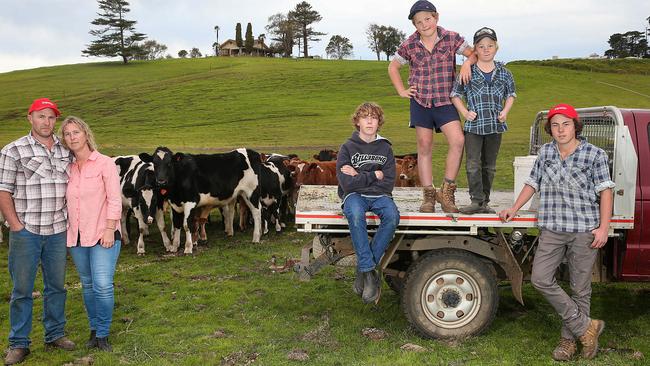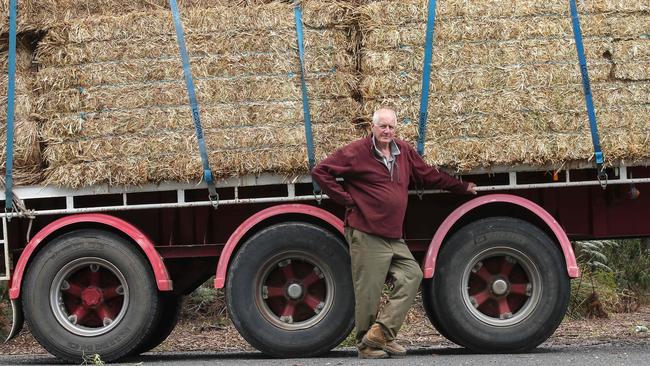Gippsland farmers feel the pinch as winter weather fails to deliver the water they need to survive
PILED high with neat bales of hay, one truck after the other rumbles down the Princes Highway. It’s the first sign that something isn’t quite right for our Victorian farmers.
VIC News
Don't miss out on the headlines from VIC News. Followed categories will be added to My News.
PILED high with neat bales of hay, one truck after the other rumbles down the Princes Highway. It’s the first sign that something isn’t quite right in eastern Victoria.
For weeks now, drivers have been carefully navigating the wide expanse between Yarram and Orbost, where lush green grass laps each fence line along the rambling southeast coast.
It’s picturesque at this time of the year.
But behind the scenery looms a country dilemma.
RELATED CONTENT:
FEMALE FARMER LEADING THE CHARGE FOR WOMEN IN THE INDUSTRY
SPUD FARMERS SERVE UP POTATO ICE-CREAM
BID TO SAVE FARMERS FROM DEPRESSION AND SUICIDE
Since January, less than 200mm of rain has fallen across the land that desperately needs it.
Winter is traditionally a period when cooler conditions and rain ensure the moisture sinks deep into the sub soil. It helps sustain crops and feeding grass through the warmer months.
This year, for the second season in a row, it hasn’t happened.

Now farmers, predominantly across Gippsland’s east, have a fight on their hands.
“The brain does tick away some nights,’’ Orbost dairy farmer Simon Barnes admitted.
“You wonder how long this can last for … when that rain will finally come.
“But you just have to put your head down and keep going.’’
The 40-year-old has 170 head of dairy cattle on a sprawling 300 acre property. He has another 100 acres 30kms up the road but no livestock there because the dams are bone dry.
It’s prime Victorian dairy country but it’s also smack bang in the middle of an area significantly affected by the weather phenomenon locals have dubbed the green drought.
“The grass is still growing,’’ Mr Barnes said.
“At the moment the farm actually looks a million bucks compared to what it was a few months ago.
“But get your hands into the subsoil and there is just no moisture there.’’
It means farmers have turned to hay provisions to help feed stock. Others have been forced to cut back herds in a bid to cut costs.
On average, a load of hay delivered to the farm gate comes with a price tag of anywhere between $6- and $10,000 depending on quality.
“Nobody can afford it, but you just have to do it,” Mr Barnes said.
The situation comes just two years after the collapse of the dairy industry pushed hundreds of farming families to the brink.
Late last year the purchase of troubled dairy processor Murray Goulburn by Canadian company Saputo offered a promise of hope of better returns.
But Mr Barnes said, just like the weather, nothing was ever guaranteed.
“You max’ yourself out financially but you just have to keep going,’’ he said.
“You do your budgets and try to stick to them but there is always unexpected costs.’’
“But you have to feed your animals to keep the business going.
“Our dams are pretty much buggered. We need some decent run off to fill them. We just have to wait.’’

Bureau of Meteorology senior climatologist David Martin said Gippsland had entered its second season with below average rainfall.
But he said there may be genuine prospects for decent rain.
“The outlook for Gippsland until September doesn’t look so bad,’’ he said.
“But it could still go either way.’’
Typically, areas along the southeast coast up as far as Gabo Island attract between 300-500mm of rain each winter.
Current records reveal less than half that.
“There have been plenty of cold fronts crossing the state but they tend to slip away before they get to Gippsland,’’ he said.
“And any weather coming from the north doesn’t have much effect because the entire region is shadowed by the Victorian alpine region.’’
READ MORE:
VICTORIAN FARMERS BATTLING THE BIG DRY
DAIRY PACKAGE IN PLACE TO HELP DESPERATE VIC FARMERS
However, there is still reasonable hope rain could fall from late winter into spring.
At 89, the green drought is nothing Neil Manning hasn’t necessarily seen before.
He’s seen farms stripped bare through lack of rain. Then wiped out by floodwaters when it finally came.
This time around he predicts the hardiest of farms would survive — just.
“You get used to it after a while,’’ he said of the unpredictability of farming.
“I bought this place back in 1960 and have experienced every up and down ever since.
“You hope for better conditions as the weeks progress but even if it does rain and farmers get the kind of returns they need — they still have to pay down the costs of keeping livestock fed.

“You can look down the highway and see the hay trucks coming. That’s how you know there are a lot of farmers out there struggling.’’
Ray Pearce, 75, has been supplying hay to farms across Gippsland for years but says this year demand had tripled.
“The phone doesn’t stop ringing,’’ he said.
“You have to feel sorry for some of these blokes.
“Some hope it’s going to rain tomorrow and they’ll get two inches of feed — but I don’t see it happening.’’
He took a gamble and ordered almost $100,000 of hay sourced from Victoria’s wheat belt knowing there was every chance demand could drop by spring.
He doubts that now.
Normally busy from May to July, he’s roped in three subcontractors to deal with the demand.
“The way it’s shaping up this year, we are going to be busy for the next 12 months.’’
He said the hardest part of the job was seeing the frustration written on the faces of those he is supplying.
He knew of one beef farmer who had been forced to cut a 500-head herd to just 50 to make ends meet.
Another elderly farmer faced the prospect of trying to rebuild levels of stock over the next five years with no guarantee he’d even be alive to see it.
“I just do the best I can for them,’’ Mr Pearce said.
“But there are some real desperate people out there for sure.’’


